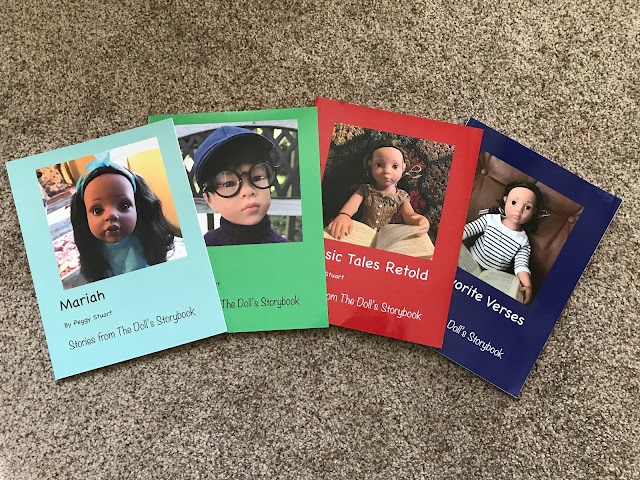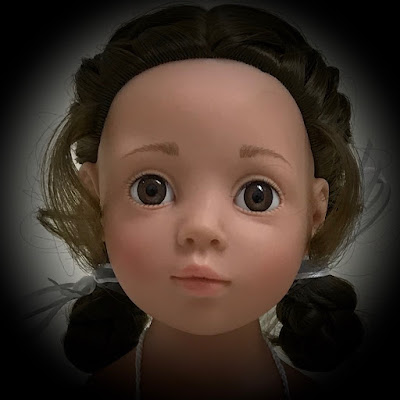"Are you doing your homework?" Emil asked when he came into the room. He climbed up on a chair so he could see better.
Charlotte and Mariah were both sitting with paper and pencil. They were both writing.
The letters looked strange to Emil. What Charlotte had written looked like this:
"What does it say?" Emil asked.
"It says, 'My name is Charlotte,'" she replied.
Emil climbed down and went to where Mariah was.
"What are you doing?" he asked her.
"I'm learning Arabic (AH-rah-bik)," Mariah explained, showing him her notebook. "It's the language we use in our worship services at the mosque (MOSK).
Emil looked at Mariah's paper. He saw this:
Emil asked Mariah what it said.
"I have written 'My name is Mariah,'" she said. "Charlotte and I were just showing each other how we introduce ourselves in our special writing."
"Mariah and I," Charlotte explained, "are learning to read and write different languages so we can use those languages in the places where we worship and can know what we're saying."
"What you are writing looks very different," Emil noticed. "It isn't just the words that are different from English, but the letters, too. They are very unusual."
"Many languages in the world" Mariah said, "use letters that are mostly the same as the letters we use in English, although they may have some special letters, too."
Charlotte nodded. "Yes, but there are also many other languages that use letters that are different, and some languages have a whole different letter for each word or part of a word."
"When you learn a new language," Mariah explained, "you have to learn the way it is written, not just how it is spoken."
Emil thought about that. "If I wanted to learn Hebrew or another new language, I would need both eyes that can see and ears that can hear," he said. "I'm really glad I have my special glasses! I think it would be fun to learn a new language."
The girls agreed. "We're glad you have your special glasses, too, Emil," Mariah said. "If you were unable to see enough to read, you would have to learn to read with your fingers. There is a special kind of writing for dolls and people who can't see well enough to read regular printing. It uses little bumps on a page. It's called Braille (BRAYL). I think that would be like learning a new language. You would read by feeling the bumps." Mariah showed Emil what she meant, using one of the books on the table. She ran her fingers along the page without looking at it.
All three dolls thought about that for a moment..
Then Emil said, "When I came in, I noticed that you were both writing from right to left. Why were you doing that?"
"Where you start writing the words is different, too, with some languages," Mariah said.
Charlotte nodded. "When we write in English and other languages that use the same letters as English does, we write from left to right. Both Hebrew and Arabic are written from right to left." Charlotte picked up her pencil and wrote "My name is Charlotte" on her pad of paper. Then she showed it to Emil.
Mariah and Charlotte think their special languages are interesting. They are the only dolls in the house who can read a special kind of writing. Their two special languages are different, but they are read in the same direction: from right to left, and they both use letters that are different from those they use to read and write in English.
"Sometimes," Mariah said, "we play a game we call, 'Naming Things.' One of us asks the other how she says something in her special language, then repeats it back."
"Sometimes we will show each other how to write the word," Mariah added.
"Sometimes we have to go and look up the word in a dictionary (DIK-shun-air-ee)," Charlotte explained. "That's a book that just has words and what they mean. Some dictionaries have the words in one language and what it means in that same language. Others have two parts: one with the words in one language and what those words mean in the other language, and the other part has the words in the other language and what the word means in the first language. We don't know all the words for everything yet."
Sometimes the other dolls will play the game with Mariah or Charlotte, too. They enjoy hearing the word for something in another language.
The other dolls know other languages besides English, but Mariah and Charlotte are the only ones who can read a language with letters that are not used in English.
Charlotte and Mariah are best friends. They like a lot of the same things. They do a lot of the same things. They do a lot of things together. They are alike in many ways, but there are also ways in which they are very different. Charlotte and Mariah love that they have ways they are the same. They love that they have ways they are different from each other. They find those differences interesting.
Do you have a friend who is different from you?
Special note to readers: When this story was written, Emil was new. He had not been out of his box very long. He is Jewish, like Charlotte, and now he is learning Hebrew, too. He also decided he wanted to learn sign language, so he could talk with dolls who can’t hear. He feels very fortunate to have his special glasses!
Cast--
Mandy: Götz Happy Kidz Katie 2015
Charlotte: Götz Happy Kidz Anna in Paris
Mariah: Götz Happy Kidz Mariah, "Chosen" from My Doll Best Friend
Emil: Götz Happy Kidz Emilia
"The Doll's Storybook" is not affiliated with Gotz Dolls USA Inc. or Götz Puppenmanufaktur International GmbH.
Watch for the next story each Friday afternoon at 1:00 PM Pacific Time.
Copyright © 2020, 2024 by Peggy Stuart




















































